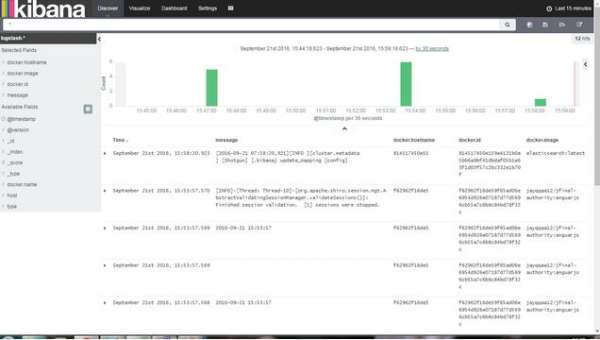为了在Docker集群中更好的管理查看日志 我们使用Docker 来搭建集群的ELK日志收集系统,这篇文章介绍了Docker构建ELK Docker集群日志收集系统的相关资料,需要的朋友可以参考下
当我们搭建好Docker集群后就要解决如何收集日志的问题 ELK就提供了一套完整的解决方案 本文主要介绍使用Docker搭建ELK 收集Docker集群的日志
ELK简介
ELK由ElasticSearch、Logstash和Kiabana三个开源工具组成
Elasticsearch是个开源分布式搜索引擎,它的特点有:分布式,零配置,自动发现,索引自动分片,索引副本机制,restful风格接口,多数据源,自动搜索负载等。
Logstash是一个完全开源的工具,他可以对你的日志进行收集、过滤,并将其存储供以后使用
Kibana 也是一个开源和免费的工具,它Kibana可以为 Logstash 和 ElasticSearch 提供的日志分析友好的 Web 界面,可以帮助您汇总、分析和搜索重要数据日志。
使用Docker搭建ELK平台
首先我们编辑一下 logstash的配置文件 logstash.conf
input { udp { port => 5000 type => json } } filter { json { source => "message" } } output { elasticsearch { hosts => "elasticsearch:9200" #将logstash的输出到 elasticsearch 这里改成你们自己的host } } 然后我们还需要需要一下Kibana 的启动方式
编写启动脚本 等待elasticserach 运行成功后启动
#!/usr/bin/env bash # Wait for the Elasticsearch container to be ready before starting Kibana. echo "Stalling for Elasticsearch" while true; do nc -q 1 elasticsearch 9200 2>/dev/null && break done echo "Starting Kibana" exec kibana
修改Dockerfile 生成自定义的Kibana镜像
FROM kibana:latest RUN apt-get update && apt-get install -y netcat COPY entrypoint.sh /tmp/entrypoint.sh RUN chmod +x /tmp/entrypoint.sh RUN kibana plugin --install elastic/sense CMD ["/tmp/entrypoint.sh"]
同时也可以修改一下Kibana 的配置文件 选择需要的插件
# Kibana is served by a back end server. This controls which port to use. port: 5601 # The host to bind the server to. host: "0.0.0.0" # The Elasticsearch instance to use for all your queries. elasticsearch_url: "http://elasticsearch:9200" # preserve_elasticsearch_host true will send the hostname specified in `elasticsearch`. If you set it to false, # then the host you use to connect to *this* Kibana instance will be sent. elasticsearch_preserve_host: true # Kibana uses an index in Elasticsearch to store saved searches, visualizations # and dashboards. It will create a new index if it doesn't already exist. kibana_index: ".kibana" # If your Elasticsearch is protected with basic auth, this is the user credentials # used by the Kibana server to perform maintence on the kibana_index at statup. Your Kibana # users will still need to authenticate with Elasticsearch (which is proxied thorugh # the Kibana server) # kibana_elasticsearch_username: user # kibana_elasticsearch_password: pass # If your Elasticsearch requires client certificate and key # kibana_elasticsearch_client_crt: /path/to/your/client.crt # kibana_elasticsearch_client_key: /path/to/your/client.key # If you need to provide a CA certificate for your Elasticsarech instance, put # the path of the pem file here. # ca: /path/to/your/CA.pem # The default application to load. default_app_id: "discover" # Time in milliseconds to wait for elasticsearch to respond to pings, defaults to # request_timeout setting # ping_timeout: 1500 # Time in milliseconds to wait for responses from the back end or elasticsearch. # This must be > 0 request_timeout: 300000 # Time in milliseconds for Elasticsearch to wait for responses from shards. # Set to 0 to disable. shard_timeout: 0 # Time in milliseconds to wait for Elasticsearch at Kibana startup before retrying # startup_timeout: 5000 # Set to false to have a complete disregard for the validity of the SSL # certificate. verify_ssl: true # SSL for outgoing requests from the Kibana Server (PEM formatted) # ssl_key_file: /path/to/your/server.key # ssl_cert_file: /path/to/your/server.crt # Set the path to where you would like the process id file to be created. # pid_file: /var/run/kibana.pid # If you would like to send the log output to a file you can set the path below. # This will also turn off the STDOUT log output. log_file: ./kibana.log # Plugins that are included in the build, and no longer found in the plugins/ folder bundled_plugin_ids: - plugins/dashboard/index - plugins/discover/index - plugins/doc/index - plugins/kibana/index - plugins/markdown_vis/index - plugins/metric_vis/index - plugins/settings/index - plugins/table_vis/index - plugins/vis_types/index - plugins/visualize/index
好了下面我们编写一下 Docker-compose.yml 方便构建
端口之类的可以根据自己的需求修改 配置文件的路径根据你的目录修改一下 整体系统配置要求较高 请选择配置好点的机器
elasticsearch: image: elasticsearch:latest command: elasticsearch -Des.network.host=0.0.0.0 ports: - "9200:9200" - "9300:9300" logstash: image: logstash:latest command: logstash -f /etc/logstash/conf.d/logstash.conf volumes: - ./logstash/config:/etc/logstash/conf.d ports: - "5001:5000/udp" links: - elasticsearch kibana: build: kibana/ volumes: - ./kibana/config/:/opt/kibana/config/ ports: - "5601:5601" links: - elasticsearch
#好了命令 就可以直接启动ELK了 docker-compose up -d
访问之前的设置的kibanna的5601端口就可以看到是否启动成功了
使用logspout收集Docker日志
下一步我们要使用logspout对Docker日志进行收集 我们根据我们的需求修改一下logspout镜像
编写配置文件 modules.go
package main import ( _ "github.com/looplab/logspout-logstash" _ "github.com/gliderlabs/logspout/transports/udp" )
编写Dockerfile
FROM gliderlabs/logspout:latest COPY ./modules.go /src/modules.go
重新构建镜像后 在各个节点运行即可
docker run -d --name="logspout" --volume=/var/run/docker.sock:/var/run/docker.sock \ jayqqaa12/logspout logstash://你的logstash地址
现在打开Kibana 就可以看到收集到的 docker日志了
注意Docker容器应该选择以console输出 这样才能采集到

好了我们的Docker集群下的ELK 日志收集系统就部署完成了
如果是大型集群还需要添加logstash 和elasticsearch 集群 这个我们下回分解。
以上就是本文的全部内容,希望对大家的学习有所帮助,也希望大家多多支持html中文网。
以上就是Docker构建ELK Docker集群日志收集系统的详细内容,更多请关注0133技术站其它相关文章!




